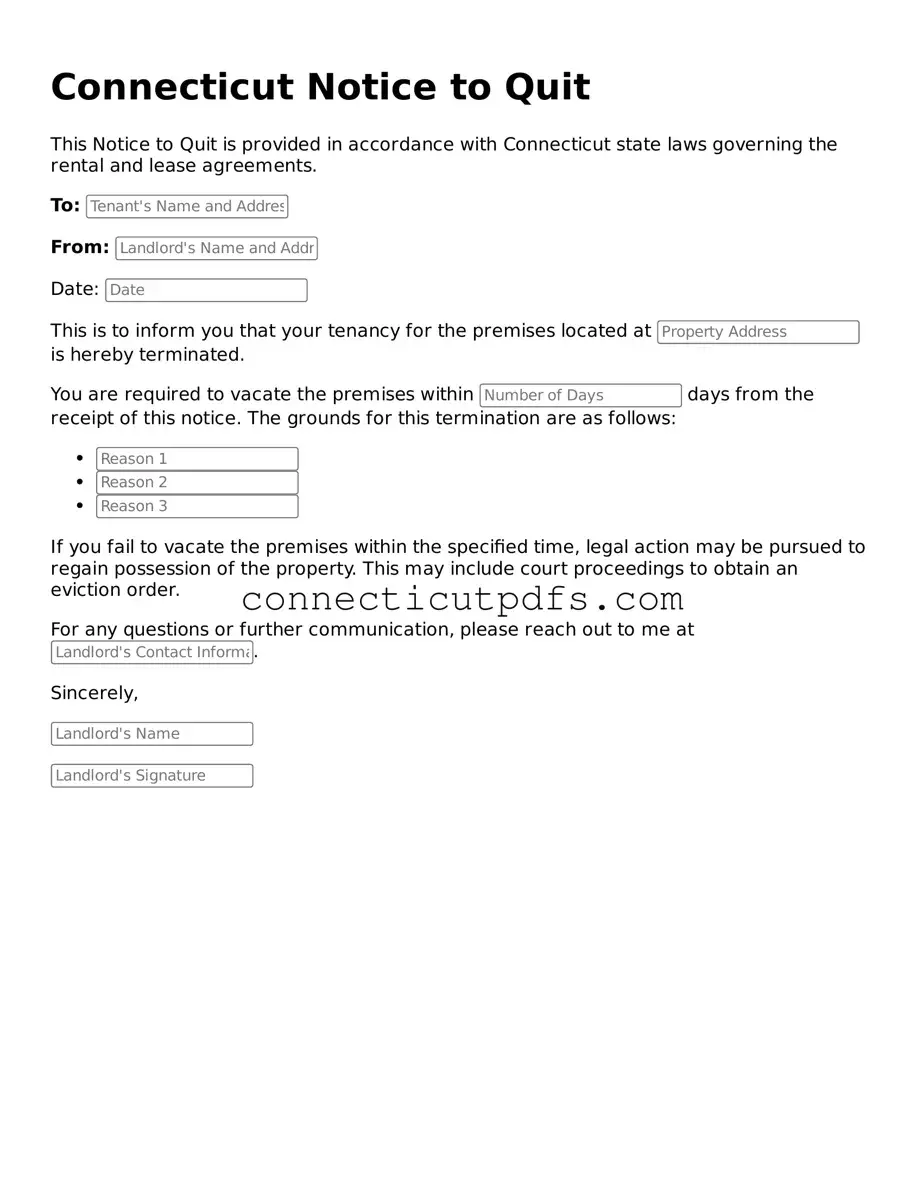What is a Notice to Quit in Connecticut?
A Notice to Quit is a legal document that a landlord uses to inform a tenant that they must vacate the rental property. This notice is typically issued when the tenant has violated the terms of the lease or has not paid rent. In Connecticut, this form serves as the first step in the eviction process, allowing landlords to formally request that tenants leave the premises.
How long does a tenant have to respond to a Notice to Quit?
The time frame for a tenant to respond to a Notice to Quit depends on the reason for the notice. If the notice is for non-payment of rent, the tenant usually has 5 days to pay the overdue rent or vacate the property. For other lease violations, the tenant may have 15 days to remedy the situation or leave. It’s crucial for tenants to read the notice carefully to understand their obligations.
Does a Notice to Quit have to be in writing?
Yes, in Connecticut, a Notice to Quit must be in writing. This written notice provides a clear record of the landlord's intent and the reasons for the request to vacate. It also ensures that the tenant has a proper understanding of the situation, which is essential for both parties involved.
What information must be included in a Notice to Quit?
A Notice to Quit should include specific details such as the tenant's name, the address of the rental property, the reason for the notice, and the date by which the tenant must vacate. Additionally, it should be signed by the landlord or their authorized agent. Including these details helps to ensure that the notice is legally valid.
Can a tenant contest a Notice to Quit?
Yes, a tenant has the right to contest a Notice to Quit. If the tenant believes the notice is unjust or that they have addressed the issues raised, they can communicate with the landlord or seek legal advice. If the matter escalates to court, tenants can present their case during the eviction proceedings.
What happens after a Notice to Quit is issued?
After a Notice to Quit is issued, the tenant must either comply by vacating the property or remedy the situation if applicable. If the tenant does not respond appropriately, the landlord may proceed with filing for eviction in court. This process can take additional time and may involve a hearing where both parties can present their arguments.
Is there a specific format for a Notice to Quit in Connecticut?
While there is no official state form for a Notice to Quit, it must adhere to certain legal requirements. It should be clearly written, easy to understand, and include all necessary information. Many landlords choose to use templates that comply with Connecticut laws to ensure that their notices are effective and legally sound.
Can a Notice to Quit be delivered in different ways?
Yes, a Notice to Quit can be delivered in several ways. It can be handed directly to the tenant, sent via certified mail, or posted on the property if the tenant is unavailable. Each method has its own implications, and landlords should choose the one that best ensures the tenant receives the notice.
What should a tenant do if they receive a Notice to Quit?
If a tenant receives a Notice to Quit, they should carefully read the document to understand the reasons for the notice and the timeframe given. It’s advisable to seek legal counsel if there are any questions or concerns. Tenants may also want to communicate with their landlord to resolve the issue amicably.
Are there any protections for tenants regarding Notices to Quit?
Yes, tenants have certain protections under Connecticut law. For instance, tenants cannot be evicted without proper notice and due process. Additionally, tenants may have defenses available to them based on the circumstances surrounding the notice, such as discrimination or retaliatory eviction. Understanding these protections can be crucial for tenants facing a Notice to Quit.
